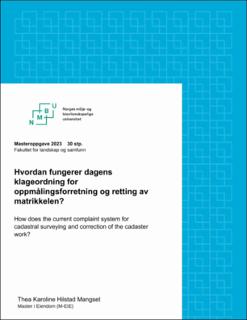| dc.contributor.advisor | Einar Hegstad | |
| dc.contributor.advisor | Leikny Gammelmo | |
| dc.contributor.author | Mangset, Thea Karoline Hilstad | |
| dc.date.accessioned | 2023-07-18T16:28:37Z | |
| dc.date.available | 2023-07-18T16:28:37Z | |
| dc.date.issued | 2023 | |
| dc.identifier | no.nmbu:wiseflow:6839533:54591857 | |
| dc.identifier.uri | https://hdl.handle.net/11250/3079920 | |
| dc.description.abstract | Formålet med denne oppgaven er å belyse dagens klageordning ved oppmålingsforretning og retting av matrikkelen. Ut ifra dette er følgende hovedproblemstilling formulert; «Hvordan fungerer dagens klageordning for oppmålingsforretning og retting av matrikkelen?». Gjennom tre underproblemstillinger skal hovedproblemstillingen belyses ved å undersøke hvordan saksbehandling og lovverk oppleves, hva kommunene gjør for å unngå klagesaker, samt om ordningen har et forbedringspotensial. For å finne ut av dette er det benyttet kombinert metode i form av en spørreundersøkelse og intervjuer av kommuner og Kartverket.
Funnene viser at det i dag er få klagesaker, og at saksbehandlingen kan variere noe fra sted til sted avhengig av hvordan man tolker loven og hvilke ressurser man har tilgjengelig. Videre viser funnene at det kan være en større belastning av klagesaker på retting av matrikkelen i mindre tettsteder enn i byene. Lovverket kan for noen oppleves litt vanskelig, og det er her ønskelig at lovverket blir litt tydeligere på hva som kan påklages.
Kommunene gjør mange forskjellige tiltak for å unngå klagesaker på oppmålingsforretning og retting av matrikkelen. De har blant annet fokus på god dialog og veiledning av partene, følge god landmålerskikk og god dokumentasjon. Det er viktig å påpeke at klager samt overprøving av Statsforvalteren ikke bør anses som negativt. Dette kan bidra til økt forståelse av lovverket, bedre rutiner og Statsforvalterens uttalelser kan være god veiledning for kommunene.
Til slutt viser resultatene at de fleste er fornøyd med dagens klageordning, men at ordningen har et forbedringspotensial. Forbedringspotensialet ligger til økt kursing, mer samarbeid og bedre rutiner. Dette vil øke kunnskapen om klagebehandling, bidra til lik praktisering og forståelse av lovverket, samt gjøre klagebehandlingen enklere for kommunen. Det ligger også et forbedringspotensial i lovverket, som kan bli litt tydeligere på hva som kan påklages.
Konklusjonen på hovedproblemstillingen «hvordan fungerer dagens klageordning for oppmålingsforretning og retting av matrikkelen?» er at dagens klageordning fungerer godt, men at det finnes et forbedringspotensial. | |
| dc.description.abstract | This thesis aims to shed light on the current complaint system for cadastral surveying and correction of the cadaster. Based on this, the following main problem is formulated; “How does the current complaint system for cadastral surveying and correction of the cadaster work?”. The thesis will examine how case management and the legislation are perceived, what the municipalities do to avoid complaints, and whether the complaints system has a potential for improvement. This thesis uses mixed methods, and both a survey and interviews are used.
The findings show that today there are few appeals and that the proceedings can vary somewhat from place to place depending on how the law is interpreted and what resources are available. Furthermore, the findings show that there can be a greater burden of appeals on correction of the cadaster in smaller towns than in the city. The legislation can be a bit difficult to understand, and the right to appeal should become clearer in the legislation.
The municipalities take many different measures to avoid complaints about cadastral surveying and correction of the cadastral register. Among other things, they focus on good dialogue and guidance of the parties, following good surveying practice and good documentation. It is important to point out that complaints and reviews by the State Administrator should not be considered negative. This can contribute to an increased understanding of the legislation and better routines, and the State Administrator's statements can be good guidance for the municipalities.
The results show that most people are satisfied with the current complaints system, but that the system has potential for improvement. The potential for improvement lies in increased training, more collaboration, and better routines. This will increase knowledge about complaint handling, contribute to equal practice and understanding of the legislation, and make complaint handling easier for the municipality.
The conclusion on the main issue “How does the current complaint system for cadastral surveying and correction of the cadaster work?” is that the current complaints system works well, but that there is potential for improvement. | |
| dc.language | nob | |
| dc.publisher | Norwegian University of Life Sciences | |
| dc.title | Hvordan fungerer dagens klageordning for oppmålingsforretning og retting av matrikkelen? | |
| dc.type | Master thesis | |
